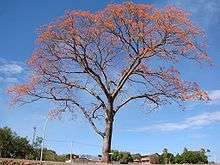Erythrina mulungu
| Mulungu | |
|---|---|
 | |
| Scientific classification | |
| Kingdom: | Plantae |
| (unranked): | Angiosperms |
| (unranked): | Eudicots |
| (unranked): | Rosids |
| Order: | Fabales |
| Family: | Fabaceae |
| Genus: | Erythrina |
| Species: | E. mulungu |
| Binomial name | |
| Erythrina mulungu Mart. ex Benth. | |
| Synonyms | |
|
Corallodendrum mulungu Kuntze | |
Erythrina mulungu (Mulungu) is a Brazilian ornamental tree and medicinal plant native to the cerrado and caatinga ecoregions in Brazil, South America.
Herbal medicine
Several Erythrina tree species are used by indigenous peoples in the Amazon as medicines, insecticides and fish poisons. Tinctures and decoctions made from the leaves or barks of Mulungu are often used in Brazilian traditional medicine as a sedative, to calm an overexcited nervous system, to lower blood pressure and for insomnia and depression.[1][2]
Commercial preparations of Mulungu are available in Brazilian drugstores, but is not very widely known in North America and almost unknown in Europe; mostly appearing as an ingredient in only a few herbal formulas for anxiety or depression.[2]
Mulungu extract composition

Chemical compounds found in Mulungu extract include the tetrahydroisoquinoline alkaloids erythravine and (+)-11α-hydroxy-erythravine.[3]
See also
- List of plants of Caatinga vegetation of Brazil
- List of plants of Cerrado vegetation of Brazil
- Bark isolates
References
- ↑ Lorenzi, H (2009-01-01). Árvores brasileiras: manual de identificação e cultivo de plantas arbóreas nativas do Brasil. (in Portuguese). Nova Odessa: Instituto Plantarum.
- 1 2 Rodrigues, V.E.G.; Carvalho, D.A. (2001-01-01). "Levantamento etnobotânico de plantas medicinais no domínio do cerrado na região do Alto Rio Grande - Minas Gerais". 25 (1). ISSN 1413-7054.
- ↑ Flausino Jr, OA; Pereira, AM; Da Silva Bolzani, V; Nunes-De-Souza, RL (2007). "Effects of erythrinian alkaloids isolated from Erythrina mulungu (Papilionaceae) in mice submitted to animal models of anxiety". Biological & Pharmaceutical Bulletin. 30 (2): 375–8. doi:10.1248/bpb.30.375. PMID 17268084.
External links
- (Portuguese) University of São Paulo: Erythrina mulungu photos